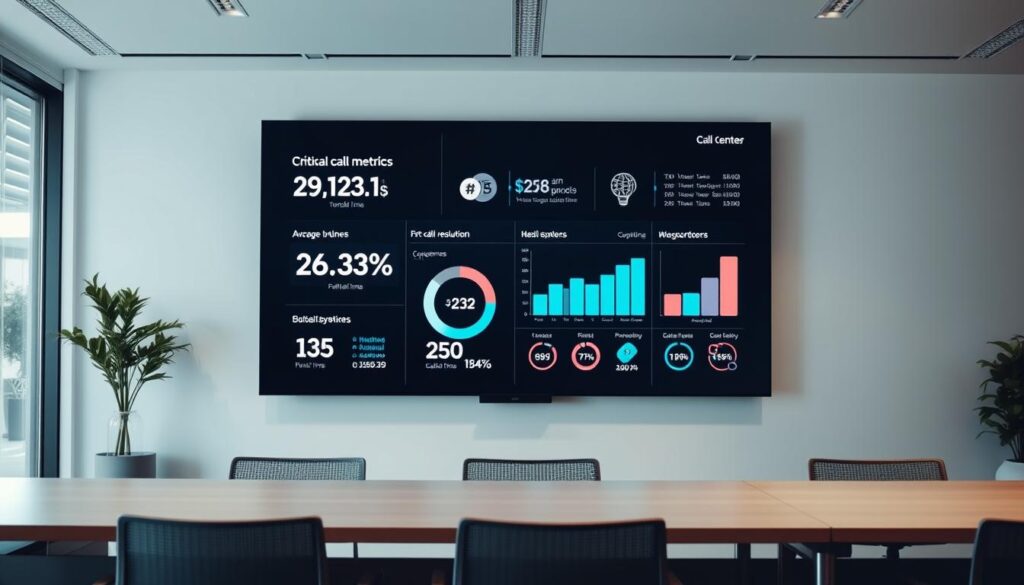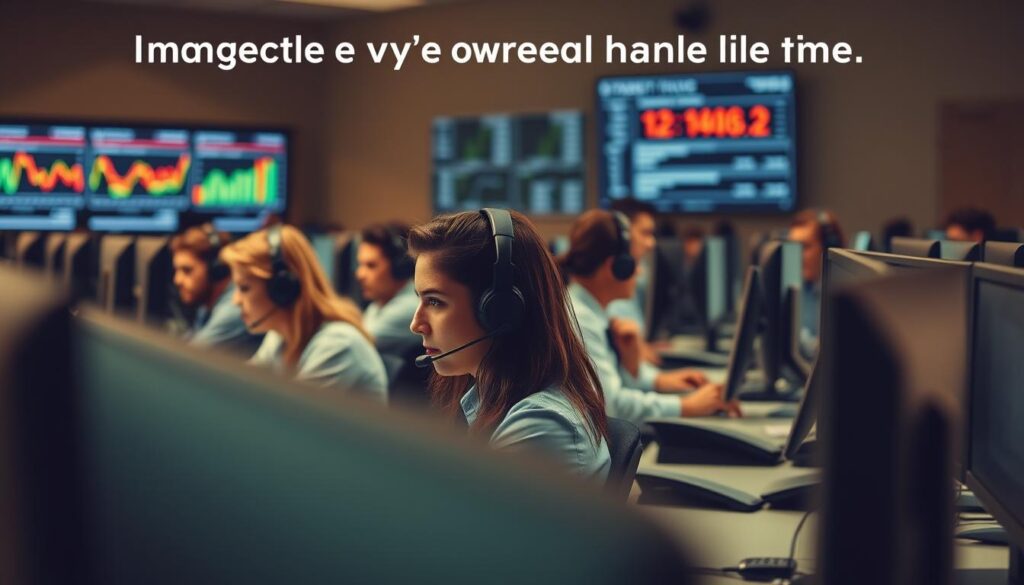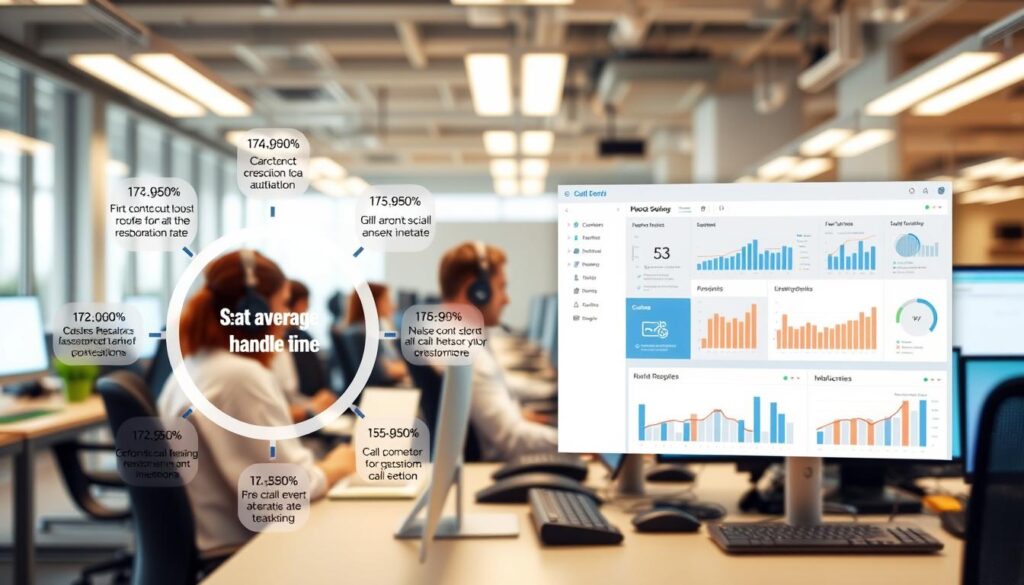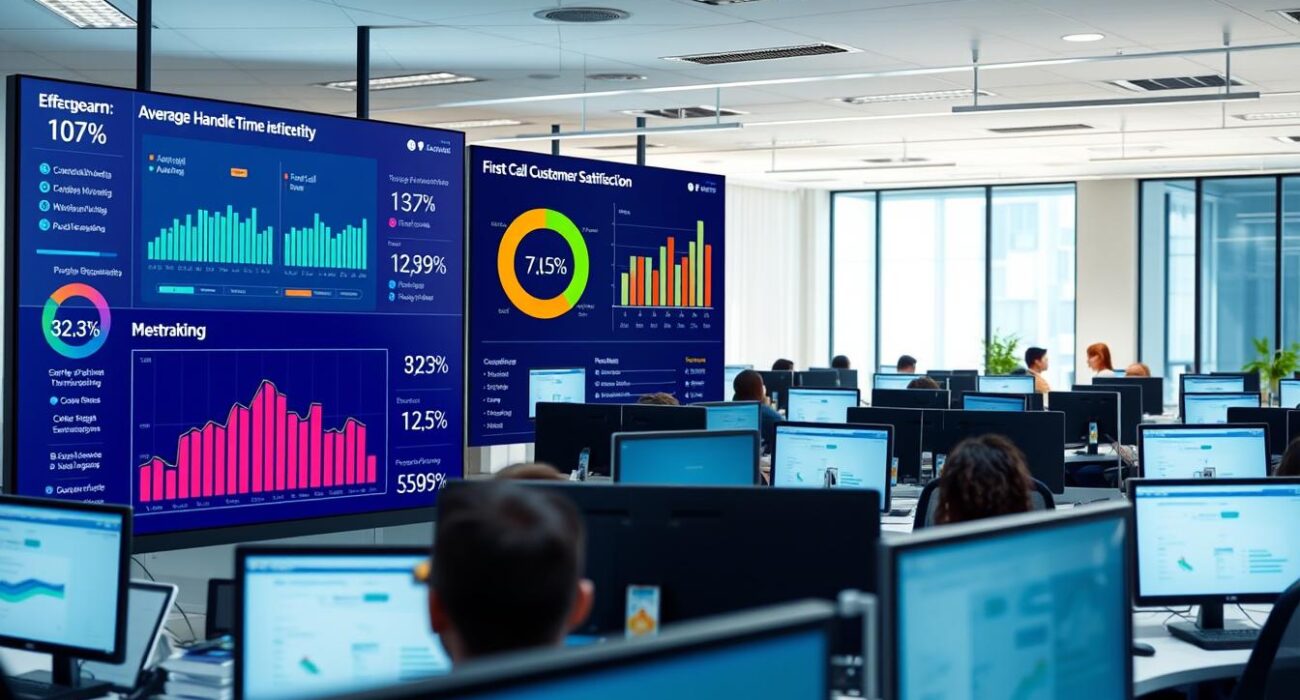Call centers face a tough challenge: balancing speed and quality. Shorter calls cut costs, but rushing can hurt customer satisfaction. How do top-performing teams strike the right balance?
Research from Cornell University reveals an industry-wide benchmark of 6.46 minutes per interaction. However, Kustomer data shows wide variations—some sectors average as low as 4.45 minutes, while others approach 8.7.
This article explores proven strategies to optimize performance without sacrificing service quality. You’ll learn how data-driven adjustments boost productivity while keeping customers happy.
What Is Average Handle Time (AHT)?
Every second counts when managing customer interactions. Average handle time (AHT) measures how long agents spend resolving issues, from greeting to wrap-up. It’s a core metric for efficiency in call centers and contact centers.
Definition and Core Components
AHT combines three phases: talk time, hold time, and after-call work (ACW). For example, billing queries often have shorter talk time but longer ACW for documentation. Technical support calls may require more hold time for troubleshooting.
The formula is simple:
(Talk Time + Hold Time + ACW) ÷ Total Calls = AHT.
Ten calls totaling 60 minutes? That’s a 6-minute AHT.
Why AHT Matters in Call Centers
Shaving just one minute off AHT can save thousands annually. Telecom companies face penalties up to 5% for missing SLAs tied to handle time. Industry data shows healthcare averages 149 seconds, while financial services hit 208.
Optimization pays off. Centrical’s clients saw a 15% boost in customer satisfaction after refining AHT. Faster resolutions don’t just cut costs—they keep customers happy.
Key Components of Average Handle Time
Three critical phases shape the efficiency of every customer interaction. Mastering these elements helps teams balance speed and service quality.
Talk Time: The Active Conversation
This phase covers the actual dialogue between agents and customers. J.D. Power found top performers let customers speak 70% of the total talk time. Quick resolutions rely on active listening and precise responses.
- Use whisper mode tools for real-time agent coaching
- Avoid interruptions to reduce repeat questions
Hold Time: Minimizing Customer Wait
Customers expect pauses under 30 seconds in 90% of cases. Exceeding 45 seconds risks 34% cart abandonment (Baymard Institute). Best practices include:
- Setting clear SLA benchmarks for total hold time
- Providing hold-time updates every 15 seconds
After-Call Work (ACW): Wrapping Up Efficiently
Documentation and follow-ups happen here. A retail center slashed 1.8 minutes off ACW using CRM shortcuts. Automation tools like Centrical cut this phase by 22%.
Agents need streamlined systems to close cases faster. Training on shortcuts ensures consistent results.
How to Calculate Average Handle Time
Numbers tell the real story of call center operations. The right formula helps teams measure performance accurately. Let’s break down how to calculate this essential metric.
The AHT Formula Explained
The standard equation combines three elements:
- Talk time: Customer conversation duration
- Hold time: Periods when calls are on hold
- After-call work: Post-call documentation
Add these three values, then divide by the total number of calls. For example:
(320s talk + 45s hold + 115s ACW) ÷ 150 calls = 3.2 minutes AHT
Practical Example: Breaking Down the Numbers
A telecom company processed 150 calls in one hour. Their data showed:
- Total talk time: 80 minutes
- Hold time: 11.25 minutes
- ACW: 28.75 minutes
Using the formula, they achieved a 4.8-minute AHT. Cloud tools like Nextiva Analytics automate these calculations.
Staffing impact: Every 10% AHT reduction saves 7 full-time agents per 100 staff. The Erlang Calculator shows 100 calls/hour at 6-minute AHT needs 11 agents.
Zendesk’s 2023 report confirms most centers fall between 4-8 minutes. Track your number calls carefully for accurate benchmarks.
Why Understanding Average Handle Time Is Critical
Behind every customer interaction lies a critical efficiency metric. Mastering it boosts agent productivity, ensures compliance, and drives revenue. Here’s why it demands attention.

Impact on Customer Satisfaction
Speed matters—but so does resolution quality. A Forrester study found a 1-minute reduction in AHT lifts NPS by 12 points. Yet, 68% of customers expect resolutions under 5 minutes (Salesforce).
Rushed calls risk frustration. Balanced efficiency keeps customer satisfaction high while meeting demand.
Relationship with Service-Level Agreements
Missed SLAs cost millions. One insurer faced $2.7M in annual fines for delays. Clear service level benchmarks prevent penalties and build trust.
Tools like Verint optimize schedules using AHT data, ensuring teams meet targets consistently.
Cost Implications for Businesses
Shaving seconds adds up. A 500-agent center saves $380K yearly with a 30-second AHT improvement. Key areas:
- Labor costs: Fewer agents handle more calls
- Compliance: FTC fines for excessive holds in healthcare
- Revenue: Faster resolutions reduce cart abandonment
Every second impacts the bottom line. Prioritizing cost implications ensures sustainable growth.
Industry Benchmarks for Average Handle Time
Efficiency looks different across call center verticals. Cornell University data reveals stark contrasts: telecom averages 8.8 minutes, while financial services hit 4.7. Retail sits in the middle at 5.4 minutes.
Average AHT by Sector
Complexity drives variation. Tech support calls take 22% longer than billing inquiries. Tier 2 issues often double the contact center AHT of Tier 1 queries.
Top performers like Amazon achieve 3.2 minutes for delivery issues. Their secret? Specialized scripts and AI-powered routing.
What’s Considered a “Good” AHT?
Balance is key. A healthcare call center averaging 3 minutes saw CSAT drop 18%. Ideal ranges:
- Retail: 4–6 minutes (returns vs. simple FAQs)
- Telecom: 7–9 minutes (plan changes need verification)
- Financial services: Sub-5 minutes for balance inquiries
Emerging AI models now predict optimal AHT per case type. But speed alone won’t protect customer experience—monitor CSAT thresholds closely.
Challenges of Managing Average Handle Time
Pressure to meet efficiency targets often creates unintended consequences in customer service. While reducing call duration matters, focusing solely on speed can harm service quality and agent performance.

Overemphasis on Speed vs. Quality
A Gallup survey reveals 62% of agents feel forced to compromise quality for faster resolutions. This creates a paradox—41% of rushed calls require follow-up contacts, actually increasing total time spent per issue.
ICMI data shows centers with high AHT often achieve better first-call resolution rates. The key is balancing efficiency with thorough problem-solving.
Agent Morale and Burnout Risks
Constant pressure to reduce call duration takes a toll. Turnover costs reach $12,000 per agent in high-pressure centers. Many teams now use gamification tools like Centrical’s dashboards to maintain agent performance without burnout.
Speech analytics help identify coaching opportunities rather than just pushing for shorter calls. This approach preserves both efficiency and service quality.
Inconsistent Measurements and Their Impact
Legacy systems often underreport after-call work by 18%, distorting true time spent per case. Without accurate data, centers struggle to set realistic high AHT benchmarks.
Modern calibration techniques using AI provide consistent scoring. They help managers identify true efficiency opportunities while maintaining excellent agent performance standards.
5 Proven Strategies to Reduce Average Handle Time
Cutting call duration without sacrificing service quality requires smart tactics. These five approaches help teams improve efficiency while maintaining excellent customer experiences.
Specialized Agent Training
Targeted agent training boosts performance quickly. Microlearning modules reduce onboarding by 19% (ATD). Focus on:
- Product knowledge drills for faster issue identification
- Active listening techniques to prevent repeat questions
- CRM shortcut mastery to cut after-call work
8×8 clients achieved 23% shorter handle times through skills-based routing. Knowledge equals speed.
Pairing High and Low AHT Agents
Peer coaching creates rapid improvements. Dell’s program delivered 14% better agents handle complex calls after implementing:
- Shadow sessions with top performers
- Joint call reviews with actionable feedback
- Weekly skill-building exercises
New agents adopt best practices faster through hands-on learning.
Call Recording and Analytics
Speech analytics uncover hidden inefficiencies. CallMiner identified 22-second savings per call by:
- Flagging unnecessary verification steps
- Reducing script deviations
- Eliminating redundant questions
Data-driven coaching targets specific agent training opportunities.
Streamlining Transfers with IVR
Smart interactive voice response systems slash misroutes. One bank cut transfers by 41% using:
- Natural language processing for accurate intent detection
- Dynamic question flows based on caller responses
- Automated authentication before agent connection
Customers reach the right expert faster, reducing total handle times.
Prioritizing Employee Engagement
Happy agents work smarter. Centrical’s gamified KPIs boosted productivity 31% by:
- Displaying real-time performance metrics
- Offering achievable daily challenges
- Recognizing top performers publicly
Engaged teams naturally improve how agents handle calls without added pressure.
Tools to Optimize Average Handle Time
Technology transforms how call centers manage efficiency. The right interactive voice systems and analytics platforms help center agents deliver faster resolutions without cutting corners.

Interactive Voice Response Systems
Modern voice response technology handles 63% of utility inquiries without agent transfer. Smart IVRs use natural language processing to:
- Route calls accurately on first attempt
- Authenticate callers before connection
- Provide self-service options for simple queries
Real-Time Monitoring and Coaching
Platforms like NICE CXone alert supervisors during compliance risks. Whisper prompts help center agents correct course mid-call. Key benefits include:
- 22% faster issue identification
- Instant script guidance for complex cases
- Performance tracking by call type
Erlang Calculators for Staffing
Adapted Erlang C formulas now account for multi-channel contacts. Calabrio’s software predicts needs based on:
- Historical time patterns
- Case complexity ratings
- Agent skill levels
Cloud solutions like Nextiva integrate these tools seamlessly. Genesys proves AI routing cuts 18% from handle durations while improving outcomes.
The Role of First-Call Resolution (FCR) in AHT
Solving customer issues on the first try changes the game for call centers. When agents resolve problems immediately, they eliminate repeat customer interactions that inflate metrics. SQM Group data proves this: just a 1% FCR improvement reduces AHT by 4 seconds.
How FCR Reduces Repeat Calls
Industry matrices show strong FCR-AHT correlations. Telecom centers with 85% FCR maintain 6.2-minute AHT, while those at 70% average 8.9 minutes. Key drivers include:
- Knowledge base integration: Salesforce Service Cloud users achieve 22% faster resolutions
- Agent empowerment: TSIA found 27% FCR boosts when auth limits increase
- Root cause analysis: Pareto charts identify top repeat-call issues
Effective first customer interactions prevent backlog buildup. Each avoided repeat call saves 4-7 minutes of future handle time.
Strategies to Improve FCR Rates
Leading centers combine technology with training. Screen-pop suggestions in CRMs like Zendesk guide agents during live calls. Best practices include:
- Pre-loaded troubleshooting steps for common issues
- Real-time access to customer purchase history
- One-click conference transfers to specialists
These methods create lasting efficiency. Verizon reduced repeat calls by 31% while maintaining 92% CSAT scores. The right tools make first-time fixes achievable.
Balancing AHT with Customer Experience
The perfect call center operation dances between speed and meaningful connections. Service quality suffers when agents rush, yet delays frustrate customers. Qualtrics research identifies 5.8 minutes as the ideal AHT-CSAT equilibrium.

Avoiding the Pitfalls of Rushed Calls
Pressure to reduce call duration backfires when agents skip vital steps. Beyond Verbal’s emotional analytics show customer satisfaction drops 22% when voice stress exceeds threshold levels.
Effective frameworks balance metrics:
- 40% weight on AHT targets
- 30% on CSAT scores
- 20% for first-call resolution
- 10% for Net Promoter Score
Integrating CSAT and NPS Metrics
Zappos’ legendary 7-minute AHT with 94 CSAT proves duration alone doesn’t define customer experience. Their secret? Real-time alerts when satisfaction indicators dip during calls.
Supervisors receive warnings when:
- Voice analytics detect frustration
- CSAT predictions fall below 85
- Calls exceed optimal duration
This approach maintains customer satisfaction while keeping handling efficient. The right balance creates loyal customers and sustainable operations.
Agent Performance and AHT: Finding the Sweet Spot
The secret to call center success lies in aligning agent capabilities with operational demands. McKinsey research shows tiered performance targets improve results by 29% compared to uniform goals. This approach balances efficiency with quality service.
Setting Realistic AHT Targets
Top performers need different benchmarks than new hires. A financial services center saw 18% better agent productivity after implementing:
- Individualized baselines based on tenure and skill level
- Monthly calibration of targets using quality scores
- Clear career paths for high-performing agents
Unionized centers add Collective Bargaining Agreement clauses. These protect workers while maintaining fair agent performance standards.
Rewarding Efficiency Without Sacrificing Quality
Incentive programs work best when they value both speed and accuracy. A telecom company achieved 22% faster resolutions by:
- Offering SPIFFs for balanced scorecard achievements
- Using 10-point QA checklists to verify call quality
- Promoting top agents to mentor roles
This strategy boosts agent productivity while keeping customer satisfaction scores high. The right balance creates sustainable results.
How Technology Can Lower Average Handle Time
Modern tools are rewriting the rules of call center efficiency. Advanced systems help agents resolve issues faster while maintaining quality customer experiences. These solutions target every phase of the interaction cycle.

AI-Powered Knowledge Bases
Intelligent systems provide instant answers during live calls. Uniphore’s conversation mining analyzes speech patterns to surface relevant solutions. This cuts research time by 40% in field tests.
Key benefits include:
- Nextiva’s contextual prompts suggest answers based on call content
- Twilio-Freshdesk integrations auto-populate case details
- Natural language processing understands complex queries
Automation for After-Call Work
IBM Watson proves automation slashes wrap-up time dramatically. Its auto-summarization feature reduces ACW by 37%. Agents get more capacity for actual customer conversations.
Leading solutions focus on:
- Robotic process automation for CRM updates
- Secure PII redaction in call transcripts
- Smart workflows between communication platforms
These innovations help centers handle higher volumes without sacrificing service quality. The right tech stack creates wins for both teams and customers.
Case Study: Successful AHT Reduction in a Retail Call Center
A major retail chain transformed its support operations through strategic efficiency improvements. Their 600-agent call center achieved a 19% reduction in handle time, dropping from 7.2 to 5.8 minutes. This case reveals how balancing speed and quality creates lasting results.
Initial Challenges and Goals
The team faced critical issues before optimization. Customer satisfaction scores languished at 34%, while SLA penalties cost $1.2M annually. Agents struggled with inconsistent processes across three regional hubs.
Leadership set clear targets:
- Reduce handle time below 6 minutes
- Boost CSAT above 80%
- Eliminate repeat calls for common issues
Implemented Solutions and Results
The turnaround involved three key initiatives. Gamified training modules improved agent speed by 22%. An IVR overhaul cut misroutes by 37%. AI-powered scripts provided real-time guidance during customer interactions.
Six months later, the call center delivered:
- $2.8M annual savings versus $410K implementation cost
- 18% lower agent turnover through better engagement
- Sustained performance for 12+ months post-launch
This success proves targeted investments in people and technology create win-win outcomes. Both efficiency and customer experience improved dramatically.
Common Mistakes When Tracking AHT
Many call centers stumble when measuring efficiency due to overlooked factors. ContactBabel research shows 58% fail to account for varying call complexity. These tracking errors distort true performance and misguide improvement efforts.
![]()
Ignoring Call Complexity
Not all customer issues require equal effort. A password reset might take 90 seconds, while technical troubleshooting could demand 12 minutes. Effective centers use complexity scoring systems:
- Implement 1-5 difficulty scales for different call types
- Compare median rather than mean handle time for skewed distributions
- Separate metrics for new versus experienced agents
Focusing Only on Averages
Raw averages often hide critical patterns. Legacy systems frequently under-sample after-call work, creating false efficiency benchmarks. Smart centers analyze:
- Technology gaps in time tracking accuracy
- Regulatory impacts like ADA compliance requirements
- Cohort performance across different shift patterns
Proper measurement reveals where to improve. Centers that adjust for these factors see 19% better handle time accuracy within six months.
Future Trends in Average Handle Time Optimization
The landscape of customer service is evolving rapidly with new technologies reshaping efficiency metrics. Emerging tools are transforming how centers manage interactions while maintaining quality. Gartner predicts 85% of service interactions will shift to self-service by 2025, fundamentally altering traditional handle time dynamics.
The Rise of Self-Service Options
Customers increasingly prefer solving issues independently. Google’s Contact Center AI now handles 43% of routine inquiries without agent involvement. Key developments include:
- Conversational AI: Natural language bots resolve tier-1 queries in under 90 seconds
- IoT integration: Smart devices initiate support requests before failures occur
- Visual IVRs: Mobile apps guide users through troubleshooting with augmented reality
These innovations reduce live customer interactions while improving resolution speed. Centers adopting such tools see 31% lower AHT for remaining agent-assisted cases.
Predictive Analytics for Call Routing
Advanced algorithms now anticipate needs before calls begin. AWS Amazon Connect analyzes:
- Previous interaction patterns
- Device type and location data
- Real-time sentiment indicators
This technology routes calls to the most suitable agent instantly. Early adopters report 28% faster resolutions and 19% higher CSAT scores. Ethical considerations remain crucial—regular audits prevent algorithmic bias in routing decisions.
Remote workforce tools also gain traction. Cloud-based quality controls ensure consistent time management across distributed teams. The future belongs to centers blending automation with human expertise.
Conclusion
Optimizing call center performance requires a strategic blend of efficiency and care. Focus on three levers: skilled agents, streamlined processes, and smart tools like AI analytics. This balance keeps customer satisfaction high while improving metrics.
An handle time audit helps identify gaps. Start by reviewing call types, agent training, and tech integrations. Over 68% of centers now invest in AI to refine these areas—proof that innovation drives results.
For teams ready to excel, ICMI certification programs offer proven frameworks. Remember: the best customer experiences happen when speed meets genuine problem-solving. Measure wisely, train consistently, and let technology handle repetitive tasks.


